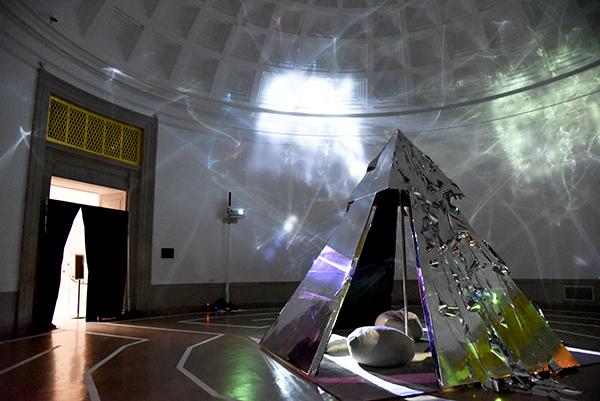Visitors stepped into the Corcoran Rotunda expecting an art exhibit, but instead they were transported to the Northern Lights.
The Echo Chamber is a short-term multimedia exhibit that opened its doors for three days earlier this month. Students and faculty from GW’s existing art program and the Corcoran School of Art and Design worked together for two months to create an immersive experience – faculty in both schools said they hope to continue projects like this in the future to bring students together.
The rotunda in the Corcoran’s 17th Street building was awash in ethereal deep purples and greens from projected lights on the ceiling, and ambient chants seemed to emanate from the walls themselves, prompting me to venture farther inward towards a pyramid set dead center in the middle of the circular room and covered in mylar. Projections of videos from historical events, both beautiful and horrible – a speech by Hitler, images from the Voyager, clips of ISIS – played on its reflective sides.
A white-tape labyrinth guided visitors into a winding journey around the exhibit that ended in the middle of the pyramid, where they could stand in the center of the “universe.” This exhibit represented life in its best and worst moments while transporting viewers to a separate dimension.
The Columbian College of Arts and Sciences funded the project with a $500 microgrant. The grant was started this year to support a collaboration specifically between Corcoran students and GW art students.
Lynn Sures, the Corcoran’s director for fine art, and Carl Gudenius, the director of the master of fine arts program at GW, spearheaded the project.
Sures and Gudenius, who had been interested in bridging the gap between their students for a few months, applied for the grant a week after it was announced and advertised the project in their respective classes.
Once they secured the grant, a team of six students – three each from the Corcoran and CCAS – and the two professors created a novel installation that engaged the senses, Gudenius said.
“The sense that you’re in another world, that it’s taking you out of this reality, is something that we hope to achieve with this,” Gudenius said.
But because of the amount of money the microgrant was worth, the group had to work around some financial limitations. They initially hoped to create a labyrinth using the CNC router, use brighter projectors and involve drones in the installation, but they couldn’t afford those expensive additions, Sures said. Mylar, the main component used to create the centerpiece pyramid, was a thrifty choice.
However, lack of money did little to curb the enthusiasm of the group, Gudenius said.
“In terms of money, we probably would have done this if someone had just said, ‘Who wants to collaborate?’” Gudenius said.
Case Baumgarten, a Corcoran student who worked on the exhibit, said the artists wanted viewers to feel involved in the artwork, rather than just looking at it.
“Our group wanted the viewer to be a part of the piece rather than just an onlooker. We wanted to create something that makes these two become one, to the point that the viewer and artwork are absorbed into each other to create a new experience for whoever enters,” Baumgarten said.
The exhibit comes about two years after GW announced it would absorb the historic art school.
Tina Roozbehi, one of the Corcoran students on the team, said spending that time together made her feel like a part of GW for the first time. Students involved in the project met for two hours each week leading up to the exhibit’s installation, and constructed it themselves in the days before it opened.
“Corcoran students are not connected to GW, so it was nice working with everyone else,” Tina Roozbehi, one of the Corcoran students on the team, said.
The Echo Chamber was on display in the Corcoran Rotunda for just three days before it was taken down to make room for the Corcoran School’s thesis exhibition NEXT, which is slated to start on April 6.







